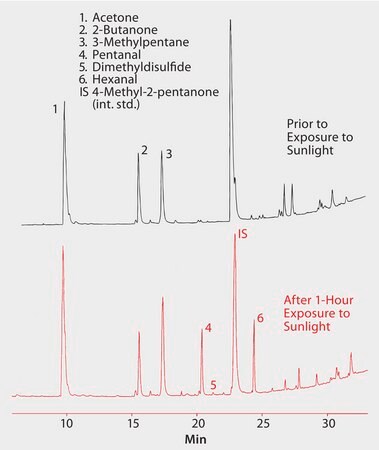GC Analysis of Volatiles in Milk (Before and After Exposure to Sunlight) on Supel-Q PLOT after SPME using a 75 μm PDMS/Carboxen Fiber

Materials
analytical column
SPME fiber
SPME fiber assembly Carboxen/Polydimethylsiloxane (CAR/PDMS)
df 75 μm(CAR/PDMS, for use with manual holder, needle size 24 garelated product
CONDITIONS
sample/matrix
3 g of 2% milk + 10 μL internal standard solution (20 μg/mL 4-methyl-2-pentanone) (9 mL GC vial)
SPME fiber
PDMS/Carboxen, 75 μm (57318)
extraction
headspace, 15 min with constant stirring at 45 °C
desorption process
5 min, 250 °C
column
Supel-Q PLOT, 30 m × 0.32 mm I.D. (24242)
oven
70 °C (2 min) to 140 °C at 6 °C/min (2 min hold) then to 220 °C at 6 °C/min (5 min hold)
inj. temp.
250 °C
detector
GC-MS ion trap, m/z = 33-300
carrier gas
helium, 35 cm/sec
injection
splitless, closed 2 min
liner
0.75 mm liner
sample
Milk
Description
Analysis Note
In this study, SPME was used for the analysis of volatiles in milk using a headspace method. Light can catalyze the formation of peroxides that can cleave double bonds in fatty acids. The cleaved by-products form aldehydes that can give the food a pungent off flavor. Dr. Ray Marsili investigated the feasibility of using SPME as a substitute sample preparation device prior to GC/MS analysis. The Carboxen/PDMS fiber was evaluated for the extraction of low ppb levels of pentanal, hexanal, and dimethyldisulfide. The results of the comparison of SPME to dynamic headspace analysis indicate that SPME-GC/MS is more accurate and precise while providing sensitivities equivalent to DH-GC/MS. The GC column used, Supel-Q PLOT, operates via gas-solid chromatography with a DVB adsorbent and permits the separation of a wide range of analytes.
Legal Information
null